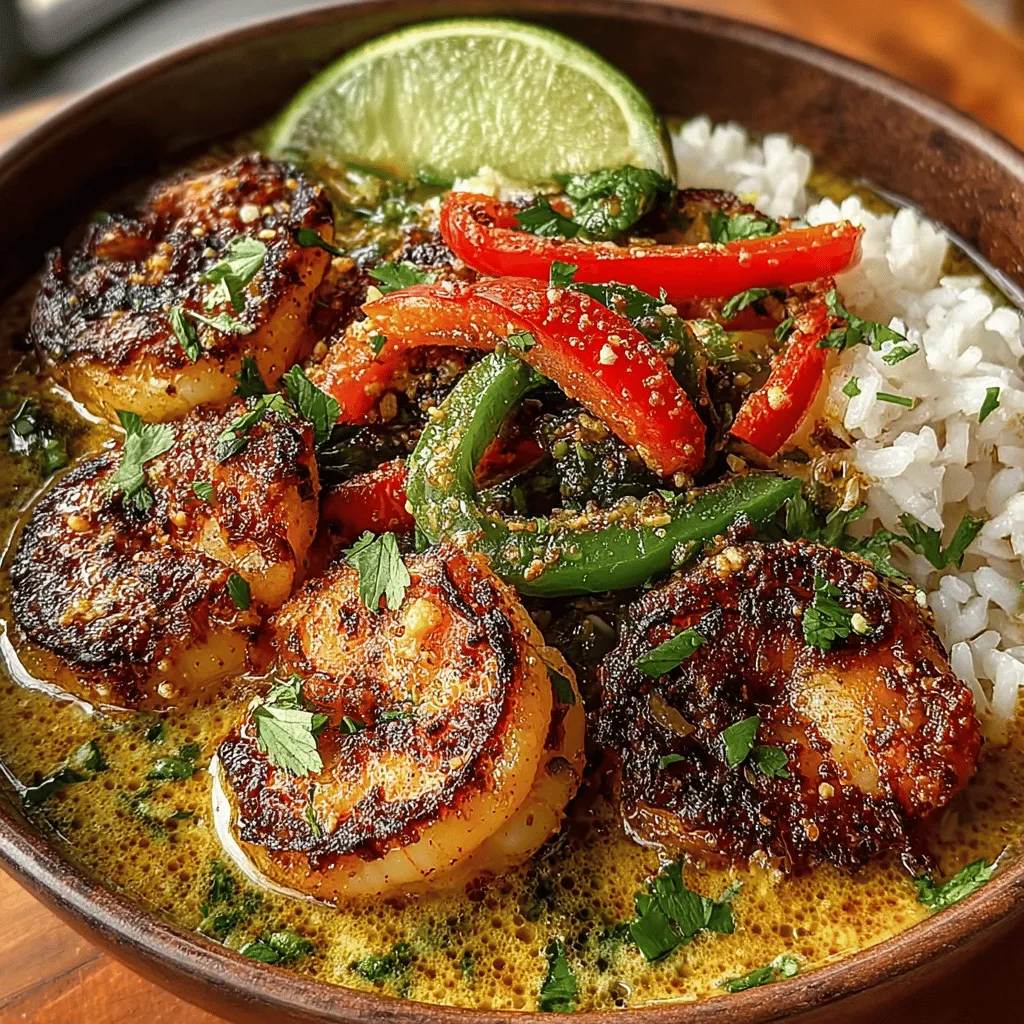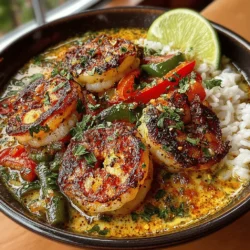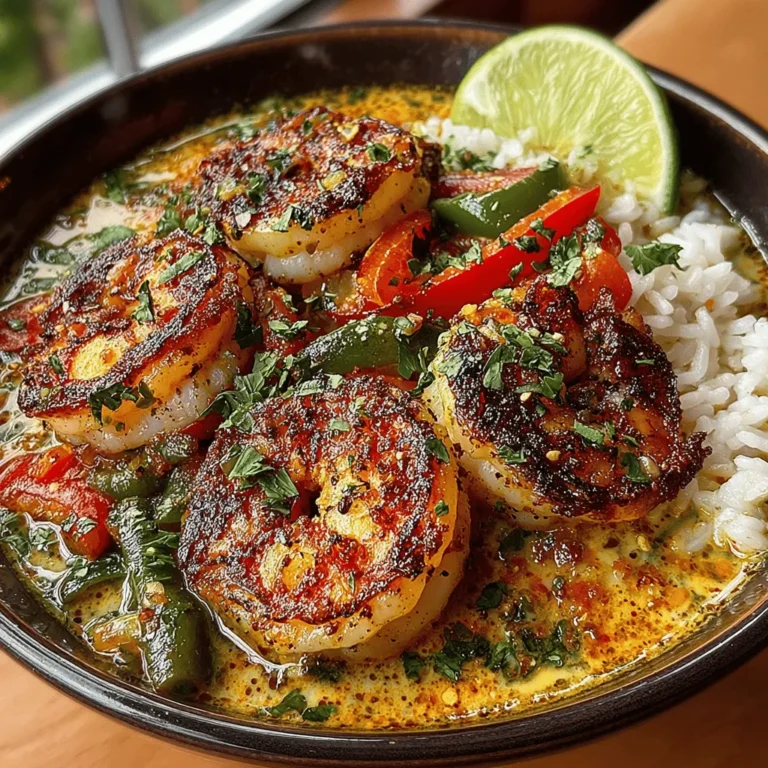Tropical Bliss Coconut Curry Shrimp is a delightful dish that brings the warmth and vibrancy of tropical cuisine right to your dining table. This recipe is a harmonious blend of succulent shrimp simmered in rich coconut milk, infused with aromatic spices and complemented by colorful vegetables. It’s a dish that not only tantalizes the taste buds but also nourishes the body, making it an excellent choice for home cooks seeking both flavor and ease.
The appeal of Tropical Bliss Coconut Curry Shrimp lies in its unique combination of flavors. The creaminess of coconut milk, the sweetness of shrimp, and the crunch of fresh vegetables create a symphony of tastes that transport you straight to a beachside paradise. In today’s fast-paced world, easy and flavorful meals are essential for home cooking, allowing us to enjoy delicious food without spending hours in the kitchen. This dish delivers on that promise, offering a quick yet satisfying meal that can be prepared in under 30 minutes.
Coconut curry dishes have a rich cultural heritage, with roots in Southeast Asian cuisine, particularly in countries like Thailand and Malaysia. Each region has its own variations, but the core elements of coconut milk and aromatic spices remain consistent. By incorporating these traditional elements into your cooking, you not only embrace a global palate but also celebrate the culinary diversity that makes food so exciting.
Understanding the Ingredients
To create the perfect Tropical Bliss Coconut Curry Shrimp, it’s essential to understand the key ingredients that contribute to its distinctive flavor and nutritional profile. Each component plays a vital role in crafting this dish.
The Role of Shrimp
Shrimp serves as the primary protein source in this recipe, providing a delicate flavor and a firm texture that pairs wonderfully with the creamy curry sauce. Rich in protein and low in calories, shrimp is an excellent choice for those looking to maintain a healthy diet. Additionally, shrimp is packed with essential nutrients such as selenium, vitamin B12, and iodine, making it a nutritious addition to your meals.
Coconut Milk: Health Benefits and Flavor Profile
Coconut milk is the star ingredient that gives this dish its creamy texture and rich flavor. It is made by blending the flesh of mature coconuts with water, creating a luscious liquid that is not only delicious but also offers several health benefits. Coconut milk is a great source of healthy fats, particularly medium-chain triglycerides (MCTs), which can support weight management and improve heart health. Its natural sweetness complements the spices in the curry, making it an ideal base for this dish.
Red Curry Paste: Origins and Flavor Contribution
Red curry paste is another essential ingredient that brings depth to the Tropical Bliss Coconut Curry Shrimp. Originating from Thai cuisine, this paste is a blend of red chilies, garlic, lemongrass, galangal, and other spices, which together create a bold and flavorful foundation for the curry. The heat level can vary depending on the brand, so it’s important to adjust the amount to suit your taste preferences. The vibrant flavor of red curry paste is what elevates this dish from ordinary to extraordinary.
Fresh Vegetables: Enhancing Nutrition and Color
In addition to shrimp and coconut milk, fresh vegetables play a crucial role in this recipe. Ingredients such as bell peppers, snap peas, and carrots not only enhance the visual appeal of the dish but also boost its nutritional value. These vegetables provide fiber, vitamins, and minerals that contribute to a well-rounded meal. When selecting vegetables, opt for a variety of colors to add visual interest and maximize the health benefits.
Optional Ingredients: Fish Sauce and Its Impact on Umami Flavor
For those looking to deepen the flavor profile of the dish, fish sauce is an optional ingredient that can be added to enhance the umami notes. This fermented condiment is commonly used in Southeast Asian cooking and adds a savory depth that complements the sweetness of the coconut milk and the heat of the curry paste. A little goes a long way, so start with a small amount and adjust to taste.
Preparation Techniques
Before diving into the cooking process, it’s crucial to prepare all ingredients properly. Efficient preparation not only saves time but also ensures that each ingredient is ready to shine in the final dish.
Step-by-Step Guide on How to Properly Peel and Devein Shrimp
1. Select Fresh Shrimp: Begin by choosing high-quality shrimp—look for firm, translucent shells with a mild ocean scent.
2. Peeling: Hold the shrimp firmly and gently remove the shell, starting from the head to the tail. If desired, leave the tail on for presentation.
3. Deveining: Use a small knife or deveining tool to make a shallow incision along the back of the shrimp. Carefully lift out the dark vein (the digestive tract) and discard it.
4. Rinse: Rinse the cleaned shrimp under cold water and pat dry with paper towels.
Tips for Selecting the Best Vegetables for the Dish
When it comes to vegetables, freshness is key. Here are some tips for selecting the best produce:
– Look for Bright Colors: Vibrant vegetables not only look appealing but are often richer in nutrients.
– Check for Firmness: Choose vegetables that are firm to the touch without any soft spots or blemishes.
– Seasonal Choices: Opt for seasonal vegetables, as they tend to be fresher and more flavorful.
Grating Ginger and Mincing Garlic: Techniques for Maximizing Flavor
Ginger and garlic are aromatic staples that add depth to the dish. To get the most flavor from these ingredients, follow these techniques:
– Grating Ginger: Use a microplane or fine grater to finely grate fresh ginger. This method releases essential oils and maximizes the flavor.
– Mincing Garlic: To mince garlic, crush the cloves with the flat side of a knife to release their juices. Then, finely chop them to your desired consistency. For an even more intense flavor, sprinkle a pinch of salt over the minced garlic and use the side of the knife to mash it into a paste.
Cooking the Coconut Curry Shrimp
Now that all ingredients are prepped and ready, it’s time to bring the Tropical Bliss Coconut Curry Shrimp to life. The cooking process is straightforward, allowing for a quick and enjoyable meal.
Importance of Sautéing Onions and Aromatics Before Adding Other Ingredients
Begin by heating a tablespoon of oil in a large skillet or wok over medium heat. Add chopped onions and sauté until they become translucent. This step is crucial as it builds the base flavor of your curry. Once the onions are softened, add the minced garlic and grated ginger. Sauté for an additional minute until fragrant. This technique allows the aromatics to release their full potential, enriching the overall flavor of the dish.
Tips for Achieving the Right Consistency with Coconut Milk
When adding coconut milk to the pan, pour it in gradually while stirring to combine. The key to achieving the perfect consistency is to allow it to simmer gently rather than boiling vigorously. If the curry seems too thick, add a splash of vegetable or chicken broth to reach your desired consistency. Conversely, if it’s too thin, let it simmer uncovered for a few extra minutes to reduce and thicken.
With these initial steps covered, you are well on your way to creating a delicious Tropical Bliss Coconut Curry Shrimp that will impress family and friends alike. Stay tuned for the next part, where we will delve into the final cooking steps and how to serve this delightful dish.

How to Tell When the Shrimp Are Perfectly Cooked
Achieving perfectly cooked shrimp is crucial for a delightful Tropical Bliss Coconut Curry Shrimp. Overcooking shrimp can lead to a rubbery texture, while undercooking may result in a less enjoyable experience. To ensure that your shrimp are cooked to perfection, observe the following indicators:
1. Color Change: Raw shrimp are typically gray and translucent. As they cook, they will turn a bright pink or orange hue, depending on the species. The flesh will also become opaque.
2. C Shape: Perfectly cooked shrimp will curl into a loose “C” shape. If they curl tightly into an “O,” they are likely overcooked.
3. Timing: Cooking shrimp usually takes between 2 to 5 minutes, depending on their size. For large shrimp, aim for around 3 minutes per side. Keep a close eye on them as they cook to prevent overcooking.
4. Internal Temperature: If you want to be precise, the internal temperature of cooked shrimp should reach 120°F (49°C). Use a food thermometer to check the temperature if desired.
By paying attention to these cues, you can ensure that your Tropical Bliss Coconut Curry Shrimp will be succulent and tender, enhancing the overall dish.
Balancing Flavors: Adjusting Sweetness and Acidity with Lime Juice and Brown Sugar
The beauty of the Tropical Bliss Coconut Curry Shrimp lies in its harmonious blend of flavors. Achieving the perfect balance between sweetness and acidity is essential to elevating this dish. Here are tips on how to adjust these elements effectively:
1. Lime Juice: The acidity from fresh lime juice brightens the dish and cuts through the richness of the coconut milk. Start with one tablespoon and taste the curry. If it feels too sweet or rich, add more lime juice gradually until you achieve the desired balance.
2. Brown Sugar: Brown sugar adds a subtle sweetness that complements the spices and coconut milk. If you find the dish leaning towards the acidic side after adding lime juice, a teaspoon of brown sugar can help to mellow it out. Just be cautious; you can always add more, but you can’t take it out.
3. Tasting as You Go: Continuously taste your curry as you adjust the flavors. This practice not only ensures that you achieve the perfect balance but also allows you to customize the dish according to your preference.
With these adjustments, you can create a dish that is both vibrant and flavorful, making your Tropical Bliss Coconut Curry Shrimp an unforgettable experience.
Serving Suggestions
Importance of Presentation in Enhancing the Meal Experience
The aesthetic aspect of a dish is just as important as its flavor. A well-presented meal not only whets the appetite but also enhances the overall dining experience. Here are some tips for presenting your Tropical Bliss Coconut Curry Shrimp beautifully:
1. Color Contrast: The vibrant colors of the shrimp and vegetables can be highlighted against a neutral background, such as white or light-colored plates. This contrast makes the dish visually appealing.
2. Layering: Serve the shrimp curry over a bed of fluffy jasmine rice. This not only creates a pleasing visual layer but also allows the rice to soak up the delicious curry sauce, enhancing the flavor of each bite.
How to Serve: Layering Shrimp Curry Over Jasmine Rice
To serve your Tropical Bliss Coconut Curry Shrimp:
1. Prepare the Jasmine Rice: Cook the jasmine rice according to the package instructions. Fluff it with a fork before serving.
2. Plate the Dish: In a shallow bowl or a wide plate, create a layer of jasmine rice. Use a ladle to scoop the shrimp curry over the rice, ensuring that each serving has a mixture of shrimp and vegetables.
3. Sauce Distribution: Allow some of the coconut curry sauce to pool around the rice. This not only adds flavor but also enhances the presentation.
Garnishing with Fresh Cilantro: Benefits and Aesthetic Appeal
Fresh herbs can elevate any dish, and for this recipe, cilantro is the perfect choice. Adding cilantro not only enhances the flavor but also adds a pop of green to your presentation. Here’s how to use it effectively:
1. Chop Finely: Use fresh cilantro leaves and chop them finely before sprinkling them over the curry. This releases their aromatic oils and amplifies their flavor.
2. Aesthetic Appeal: The vibrant green of the cilantro contrasts beautifully with the golden coconut curry, making the dish visually enticing.
3. Flavor Enhancement: Cilantro adds a fresh, citrusy flavor that complements the sweetness of the coconut milk and the spices in the dish.
Optional Presentation Tips: Using Colorful Bowls and Lime Wedges
If you want to take your presentation a step further:
– Colorful Bowls: Use vibrant, colorful bowls or plates to serve your Tropical Bliss Coconut Curry Shrimp. Bright colors can enhance the dish’s appeal and make it more inviting.
– Lime Wedges: Serve lime wedges on the side. This not only offers a fresh accent for guests who enjoy extra acidity but also adds to the visual presentation of the dish.
Nutritional Information
Overview of the Health Benefits of the Ingredients
The Tropical Bliss Coconut Curry Shrimp is not only delicious but also packed with nutritional benefits. Here’s a breakdown of the health advantages of the key ingredients:
1. Shrimp: High in protein and low in calories, shrimp is an excellent choice for those seeking a healthy source of protein. They are also rich in omega-3 fatty acids, which are beneficial for heart health.
2. Coconut Milk: This ingredient is a great source of healthy fats, particularly medium-chain triglycerides (MCTs), which may support weight management and provide quick energy. Additionally, coconut milk is a lactose-free alternative, making it suitable for those with lactose intolerance.
3. Vegetables: The bell peppers and spinach included in the recipe provide essential vitamins and minerals. Bell peppers are high in vitamin C, while spinach is an excellent source of iron, calcium, and antioxidants, contributing to overall health.
Suggested Modifications for Dietary Preferences
If you or your guests have dietary preferences or restrictions, there are easy modifications you can make:
– Vegetarian or Vegan Options: To make this dish vegetarian or vegan, replace the shrimp with chickpeas or tofu. Both options provide protein while absorbing the flavors of the curry beautifully.
– Gluten-Free: This recipe is naturally gluten-free. Just ensure that any additional ingredients, such as sauces or condiments, are also gluten-free.
– Low-Carb Option: For a low-carb version, skip the rice and serve the curry over steamed cauliflower rice or zucchini noodles for a lighter alternative.
Cultural Context of Coconut Curry
Historical Background of Coconut Curry in Southeast Asian Cuisine
Coconut curry has deep roots in Southeast Asian cuisines, particularly in countries like Thailand, Malaysia, and Indonesia. The use of coconut milk in cooking dates back centuries, often utilized for its creamy texture and ability to balance spices.
In Thailand, for instance, coconut curry is a staple, where the balance of sweet, spicy, and savory flavors creates a complex and satisfying dish. The incorporation of fresh herbs, spices, and vegetables is reflective of the region’s agricultural abundance and culinary diversity.
Variations of Coconut Curry Across Different Cultures
While the essence of coconut curry remains, variations exist across different cultures:
– Thai Curry: Typically, Thai curries use a variety of curry pastes (red, green, or yellow) blended with coconut milk and a mix of proteins and vegetables.
– Indian Curry: Indian versions may include a variety of spices and often use yogurt or cream in place of coconut milk, offering a different flavor profile.
– Malaysian Curry: Malaysian curries often incorporate local spices and herbs, resulting in a unique taste that reflects the region’s multicultural influences.
The Tropical Bliss Coconut Curry Shrimp recipe reflects this rich cultural tapestry, blending techniques and flavors from various culinary traditions to create a fusion dish.
Conclusion
In summary, the Tropical Bliss Coconut Curry Shrimp is a delightful culinary experience that marries vibrant flavors, nutritional benefits, and ease of preparation. With its perfectly cooked shrimp, balanced sweetness and acidity, and gorgeous presentation, this dish is sure to impress.
Whether you’re hosting a dinner party or simply looking to treat yourself to a comforting meal, this recipe offers a fantastic balance of taste and health benefits. The flexibility of the ingredients allows for adaptability to various dietary preferences, ensuring that everyone can enjoy this delicious dish.
We encourage you to explore this recipe, experiment with your adaptations, and share your culinary creations with others. The joy of cooking and sharing food is a wonderful way to connect with family and friends, and the Tropical Bliss Coconut Curry Shrimp is an excellent dish to facilitate those moments. Enjoy your cooking!


